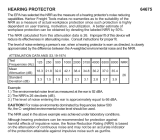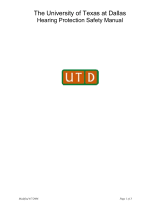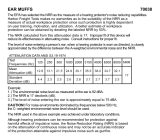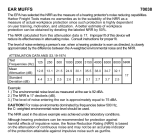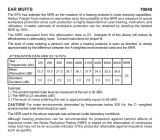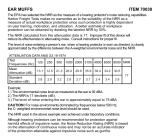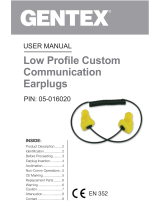Effective
for anyone who needs to
hear accurately in a noisy
environment…
61 Martin Lane, Elk Grove Village, IL 60007
847-228-0006 www.etymotic.com
The ER family of earplugs is covered by three U.S. patents:
4,852,683; 5,113,967; 5,887,070.
MicroPro and Isolator Earphones are trademarks of Etymotic Research.
ER-9-15-25/20FG-15-07/02 ©2002 ETYMOTIC RESEARCH
What’s wrong with conventional earplugs?
Conventional earplugs attenuate more in the high frequencies than in the low and mid frequencies, which makes
music and voices unclear and unnatural. Deeply inserted foam earplugs can provide 30-40 dB of attenuation, although
typically only a small amount of sound reduction is needed.
How much protection is needed?
Noise-induced hearing loss is a function of exposure time, the average sound level and the peak level of very loud
sounds. OSHA set industrial limits of 8 hours per day at 90 dBA. NIOSH recommends a maximum allowable exposure of
40 hours per week at 85 dBA.
What are the two greatest sources of error with
Musicians Earplugs?
1) Earmold impressions that are not long enough (past the second bend)
2) Earmolds received from the earmold lab that are not long enough
How can the occlusion effect be reduced?
Deep earmold impressions (past the second bend of the ear canal) are required because earmolds that do not seal
deeply in the bony portion of the ear canal can create the occlusion effect. A shallow earmold can increase the occlusion
effect by as much as 15-20 dB at low frequencies. Silicone impression material is recommended. Vented otoblocks
decrease the likelihood of discomfort or damage to the ear during removal of deep
impressions. If a remake is necessary because of the occlusion effect, it may be
helpful for the person to vocalize “oo” or “ee” while the impression is setting.
Open-jaw impressions are also an option.
How can the occlusion effect be measured?
Etymotic Research produces a hand-held Occlusion Effect Meter which quickly
quantifies the occlustion effect and earmold leakage. This information can reduce the
need for remakes.
What is NRR (Noise Reduction Rating)?
The EPA requires manufacturers to print a noise reduction rating (NRR) on all non-custom earplugs. The NRR
for ER-20s is 12 dB, but actual clinical measurements of properly inserted ER-20s indicate that these earplugs
provide almost equal sound reduction (20 dB) at all frequencies. The required formula used to determine NRR
includes an adjustment for individual variability and for those persons who do not wear ear protection as instructed.
Many investigators have found no consistent rank order correlation between the real-world NRRs and labeled NRRs.
NRR is computed from laboratory data that are not representative of the values attained in the real world by actual users.
Aircraft
crew
flight instructors
passengers
pilots
Frequently Asked Questions:
Sound level (dB) Exposure type No protection Using ER-20s
60 Conversation SAFE –
80-85 Noisy restaurant 40 HRS. SAFE
Vacuum cleaner
Average factory
88 Circular saw 20 HRS. SAFE
Loud party
Motorcycle
94 Subway 5 HRS. SAFE
Riding mower
97 Live band 2.5 HRS. 40 HRS.
100 Sporting event 1.25 HRS. 20 HRS.
Chain saw
Snowmobile
112 Blues bar/Rock concert 5 MINS. 1.25 HRS.
115 Ambulance siren 2.5 MINS. 36 MINS.
140 Jet engine INSTANT LOSS
Gun shot
Firecracker
Above 125 dB you are at risk for any period without maximum protection
Recommended Maximum Weekly Exposure
(NIOSH, 1998)
OSHA and NIOSH values listed above are given
in daily exposure limits. According to the OSHA
standard, a person can be exposed to a 95 dB
environment for 4 hours before risking hearing
damage. With 10 dB of protection that person
can be exposed to 95 dB for 16 hours per day.
NIOSH values are more conservative.
For maximum protection, foam earplugs, muffs or
other hearing protection devices are recommended.
Allowable Daily Exposure
(OSHA and NIOSH)
Source Level OSHA NIOSH
(in dB)
85 16 8
88 4
90 8
92 6
94 1
95 4
3
/
4
97 3
1
/
2
100 2
1
/
4
105 1
110
1
/
2
115
1
/
4
120
1
/
8
Industrial
factory workers
shop teachers
students
supervisors
Leisure
concerts
night clubs
noisy restaurants
sporting events
Others
delivery drivers
market traders
night club staff
truck drivers
Construction
carpenters
equipment operators
road builders
steel workers
Aircraft
crew
flight instructors
passengers
pilots
Athletics
athletes
coaches
Medical-Dental
dentists
dental hygienists
dental technicians
surgeons
Athletics
athletes
coaches
Construction
carpenters
equipment operators
road builders
steel workers
Leisure
concerts
night clubs
noisy restaurants
sporting events
Industrial
factory workers
shop teachers
students
supervisors
Medical-Dental
dentists
dental hygienists
dental technicians
surgeons
Others
delivery drivers
market traders
night club staff
truck drivers
Motor Sports
motorcyclists
pit crews
race car drivers
Motor Sports
motorcyclists
pit crews
race car drivers
Emergency
Vehicles
EMTs
highway patrol
firefighters
Emergency
Vehicles
EMTs
highway patrol
firefighters




